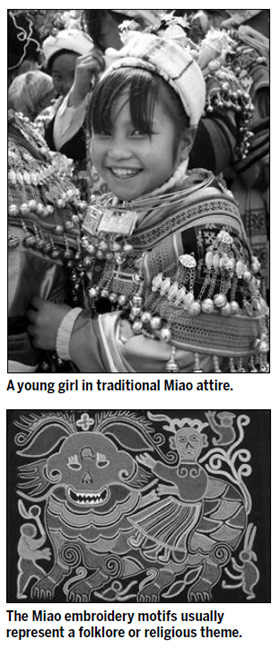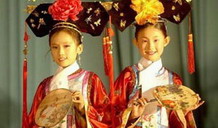A stitch in time
Trading Miao embroidery has improved her quality of life, Liu says. "I can now make around 1,000 yuan per month on average after paying for my dorm and booth rental," she says.
Although this is not a large income by Beijing standards, Liu has been able to buy a new apartment in her hometown from her earnings.
Now there are around 20 stores and booths that retail Miao handicraft in Panjiayuan.
However, as the workshops producing machine embroidered pieces are doing well, the art of hand-made Miao embroidery seems to be on the decline.
 |
Wei Ronghui noted that 80 to 90 percent of Miao needlework in the market is machine-made.
But, 20 years ago, when Miao embroidery first entered the markets, they were all handmade. Zeng Li, curator of Guizhou Ethnic Culture Museum, says: "At that time the embroidery would be done to meet traditional needs. But customers' needs have changed. Most of them prefer cheap ones to put up on the wall, for which machine-made embroidery is good enough."
She fears that the art of hand-made embroidery will soon be wiped out completely, given machine-made products cost much less.
A handmade piece taking more than three months to complete often sells for only 300-400 yuan, which is putting off a lot of the craftsmen from practicing this ancient and painstaking art, Wei explains.
Young girls no longer stay at home, but go out looking for employment in the Miao embroidery factories or in the big cities.
In Liu Ying's village, over 50 percent of her fellow villagers work away from home.
In fact, few Miao people selling ethnic embroidery in cities have any idea about their mythology - the history of the ethnic group's migration and evolution - that inspires the traditional patterns.
"The dragon doesn't represent 'royalty' as it would in Han culture. In Miao culture it stands for auspiciousness," Zeng Li says.
Any pattern or symbol on clothes, Zeng points out, is meant to convey a message, "as Miao people have no written language". All the more reason why Miao symbols and embroidery must be preserved, she adds.
Local authorities have now introduced a series of projects to help keep this ancient artistic heritage alive.
A digital museum showcasing thousands of Miao embroidered artworks will open in 2011 in Guizhou. A database featuring the history, features and artistic value of Miao embroidery is now on public view.
Yang Xiaohui, the database's project director from the provincial culture and art research institute, began working on the project in 2008. He traveled around the eight provinces where the Miao mainly live, collecting information. "At least we would still have some literature and files on Miao embroidery, should it die out," Yang says.
Meanwhile, some schools in Guizhou provide incentives to students to learn about Miao embroidery.
"Many Miao mothers have gone to work in cities, leaving their daughters at home with virtually no one to teach them the art of stitching," says Wei Ronghui. "Hopefully, the schools can equip these children with some basic skills of Miao embroidery."
By Liu Xin
Editor: Liu Fang






